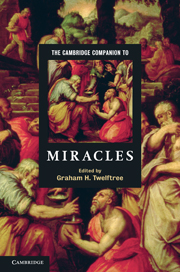1 - What is a miracle?
from Part I - Fundamental issues
Published online by Cambridge University Press: 28 May 2011
Summary
The concept of miracle is very important in many religions, as evidence of both God’s existence and God’s benevolent presence in our world. However, the meaning of ‘miracle’ often differs significantly, even within a given religion. Moreover, a number of these meanings have generated important critical discussion. The main purpose of this chapter is not to discuss whether miracles do occur (ontological or metaphysical questions) or can be known to occur (epistemological questions). The main purpose is to outline the various meanings or definitions of miracle, note some of the conceptual difficulties, and when relevant share my own perspective.
In its most general sense, a miracle is something quite unusual or unexpected. Some use the term to describe any unexpected event – from an unanticipated job offer, to the rediscovery of a hopelessly lost heirloom, to the rapid, welcomed change in a person’s behaviour. More commonly, the term is used in a more restricted manner, being applied only to those very unusual events that we would not have expected to occur, given the relevant natural laws – events such as the survival of a fall from the top of a tall building or the immediate total recovery of a person dying of cancer.
When used in either of these general senses, the events labelled miracles are often assumed to be solely the result of non-purposeful natural activity – that is, are understood to be events we would not have expected, given the natural order, but that are in principle fully explainable naturally. In religious contexts, however, the term ‘miracle’ has a narrower focus. It is normally applied to unusual, remarkable events that it is assumed would not have occurred in the context in question if not for the intentional activity of a supernatural being.
- Type
- Chapter
- Information
- The Cambridge Companion to Miracles , pp. 17 - 35Publisher: Cambridge University PressPrint publication year: 2011
- 4
- Cited by

